IT Project Report: Project Organization, Scope, and Objectives
VerifiedAdded on 2020/01/07
|12
|2359
|140
Report
AI Summary
This report provides an in-depth analysis of an IT project, examining its organizational structure, scope, and objectives. The project, undertaken at Dell Engineering Services for Caterpillar Inc., involved the implementation of Siemens' Team Center for Systems Engineering (TcSE) software. The report details the project's three-tier scope, encompassing integration, training material generation, and ongoing support. It highlights the importance of understanding project scope and objectives, discussing potential issues arising from incorrect timelines and the methodology employed. The report also discusses the traditional project management approach, quality management's significance, advantages of high quality, and disadvantages of low quality. The project timeline, tasks, and responsibilities of various team members are also examined, providing a comprehensive overview of the IT project's execution and management.

Running Head: IT PROJECT 1
IT Project
Name
University
Lecturer
Date
IT Project
Name
University
Lecturer
Date
Paraphrase This Document
Need a fresh take? Get an instant paraphrase of this document with our AI Paraphraser
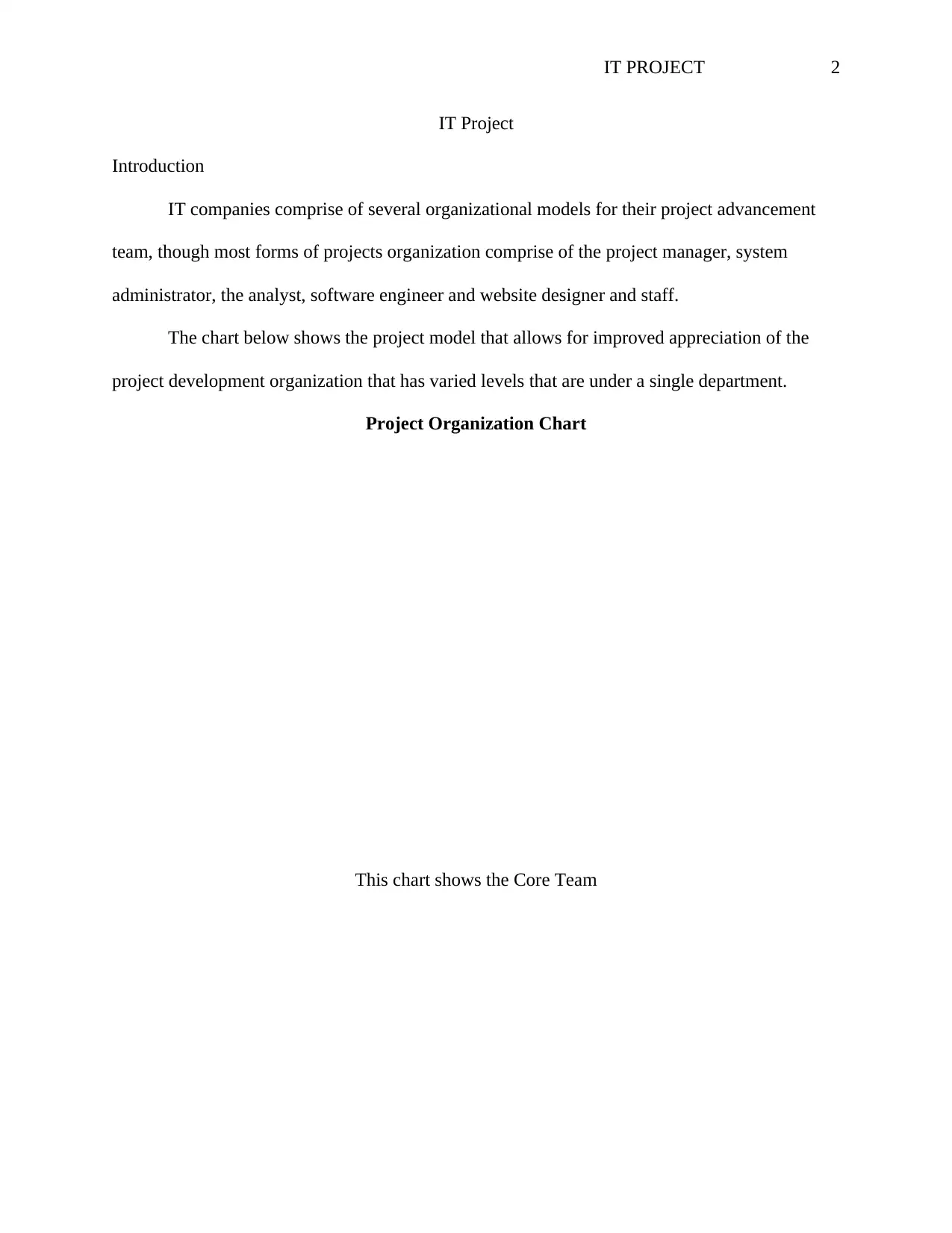
IT PROJECT 2
IT Project
Introduction
IT companies comprise of several organizational models for their project advancement
team, though most forms of projects organization comprise of the project manager, system
administrator, the analyst, software engineer and website designer and staff.
The chart below shows the project model that allows for improved appreciation of the
project development organization that has varied levels that are under a single department.
Project Organization Chart
This chart shows the Core Team
TechnicalTraining
IT Project
Introduction
IT companies comprise of several organizational models for their project advancement
team, though most forms of projects organization comprise of the project manager, system
administrator, the analyst, software engineer and website designer and staff.
The chart below shows the project model that allows for improved appreciation of the
project development organization that has varied levels that are under a single department.
Project Organization Chart
This chart shows the Core Team
TechnicalTraining
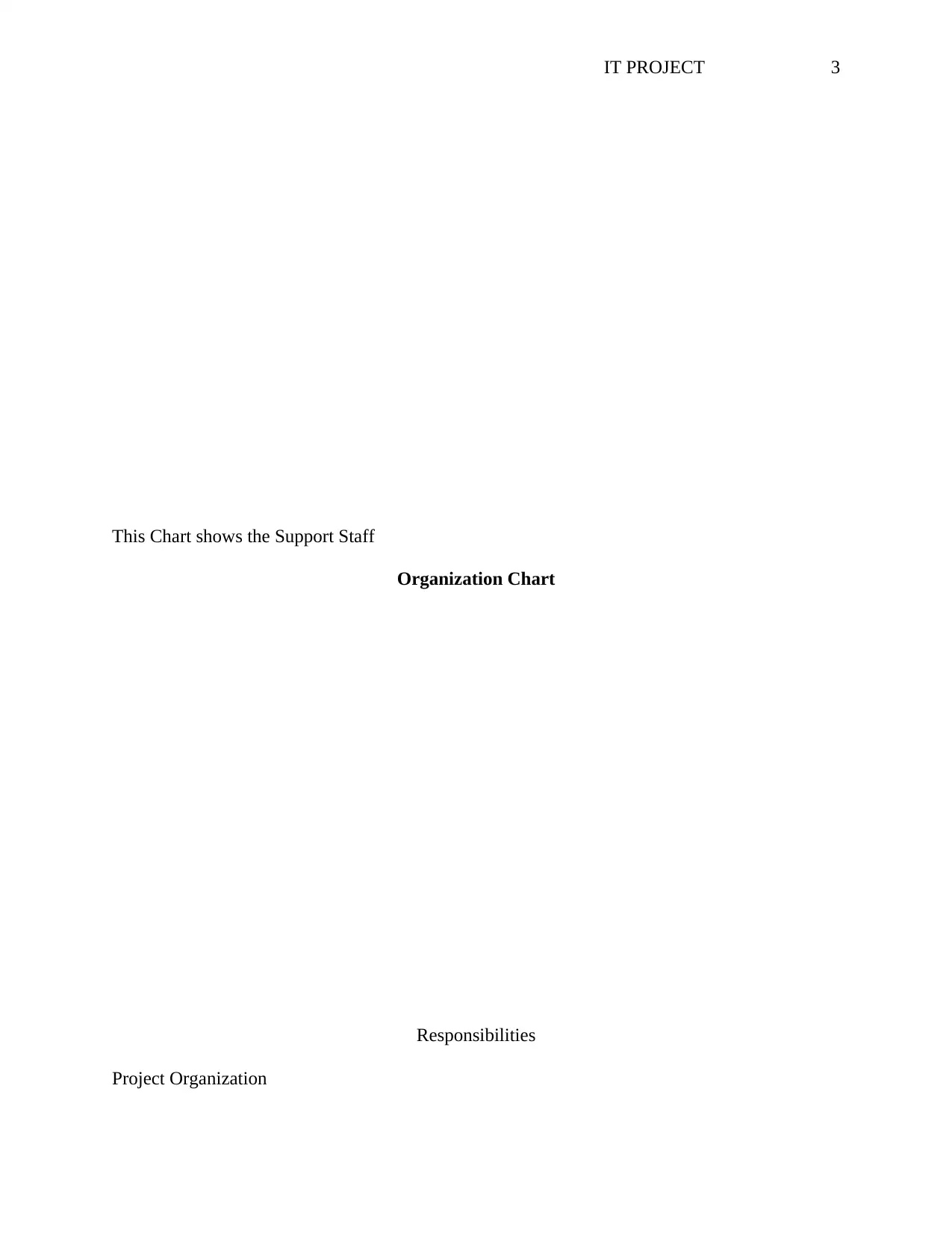
IT PROJECT 3
This Chart shows the Support Staff
Organization Chart
Responsibilities
Project Organization
1234PresidentVP-Sales
This Chart shows the Support Staff
Organization Chart
Responsibilities
Project Organization
1234PresidentVP-Sales
⊘ This is a preview!⊘
Do you want full access?
Subscribe today to unlock all pages.

Trusted by 1+ million students worldwide
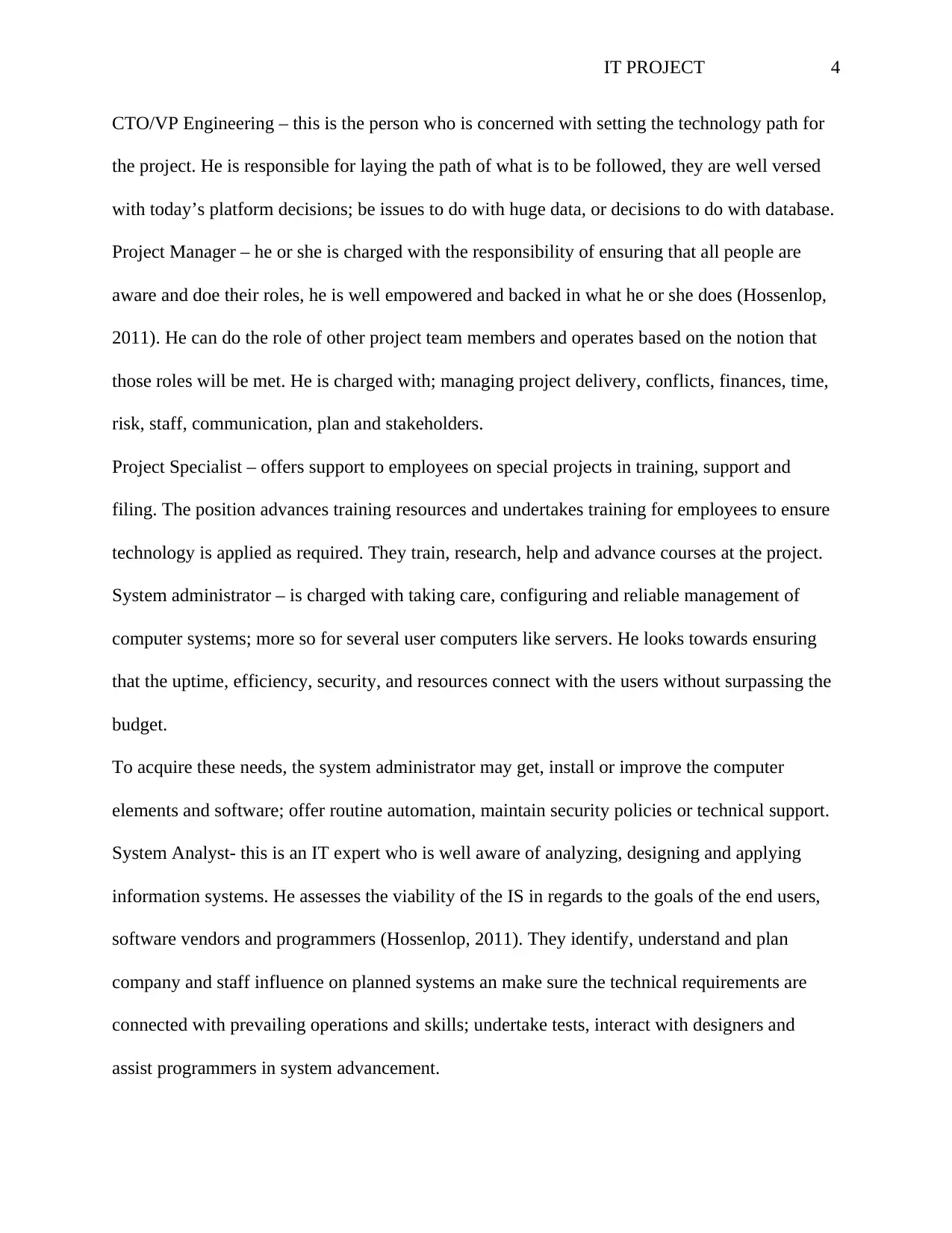
IT PROJECT 4
CTO/VP Engineering – this is the person who is concerned with setting the technology path for
the project. He is responsible for laying the path of what is to be followed, they are well versed
with today’s platform decisions; be issues to do with huge data, or decisions to do with database.
Project Manager – he or she is charged with the responsibility of ensuring that all people are
aware and doe their roles, he is well empowered and backed in what he or she does (Hossenlop,
2011). He can do the role of other project team members and operates based on the notion that
those roles will be met. He is charged with; managing project delivery, conflicts, finances, time,
risk, staff, communication, plan and stakeholders.
Project Specialist – offers support to employees on special projects in training, support and
filing. The position advances training resources and undertakes training for employees to ensure
technology is applied as required. They train, research, help and advance courses at the project.
System administrator – is charged with taking care, configuring and reliable management of
computer systems; more so for several user computers like servers. He looks towards ensuring
that the uptime, efficiency, security, and resources connect with the users without surpassing the
budget.
To acquire these needs, the system administrator may get, install or improve the computer
elements and software; offer routine automation, maintain security policies or technical support.
System Analyst- this is an IT expert who is well aware of analyzing, designing and applying
information systems. He assesses the viability of the IS in regards to the goals of the end users,
software vendors and programmers (Hossenlop, 2011). They identify, understand and plan
company and staff influence on planned systems an make sure the technical requirements are
connected with prevailing operations and skills; undertake tests, interact with designers and
assist programmers in system advancement.
CTO/VP Engineering – this is the person who is concerned with setting the technology path for
the project. He is responsible for laying the path of what is to be followed, they are well versed
with today’s platform decisions; be issues to do with huge data, or decisions to do with database.
Project Manager – he or she is charged with the responsibility of ensuring that all people are
aware and doe their roles, he is well empowered and backed in what he or she does (Hossenlop,
2011). He can do the role of other project team members and operates based on the notion that
those roles will be met. He is charged with; managing project delivery, conflicts, finances, time,
risk, staff, communication, plan and stakeholders.
Project Specialist – offers support to employees on special projects in training, support and
filing. The position advances training resources and undertakes training for employees to ensure
technology is applied as required. They train, research, help and advance courses at the project.
System administrator – is charged with taking care, configuring and reliable management of
computer systems; more so for several user computers like servers. He looks towards ensuring
that the uptime, efficiency, security, and resources connect with the users without surpassing the
budget.
To acquire these needs, the system administrator may get, install or improve the computer
elements and software; offer routine automation, maintain security policies or technical support.
System Analyst- this is an IT expert who is well aware of analyzing, designing and applying
information systems. He assesses the viability of the IS in regards to the goals of the end users,
software vendors and programmers (Hossenlop, 2011). They identify, understand and plan
company and staff influence on planned systems an make sure the technical requirements are
connected with prevailing operations and skills; undertake tests, interact with designers and
assist programmers in system advancement.
Paraphrase This Document
Need a fresh take? Get an instant paraphrase of this document with our AI Paraphraser
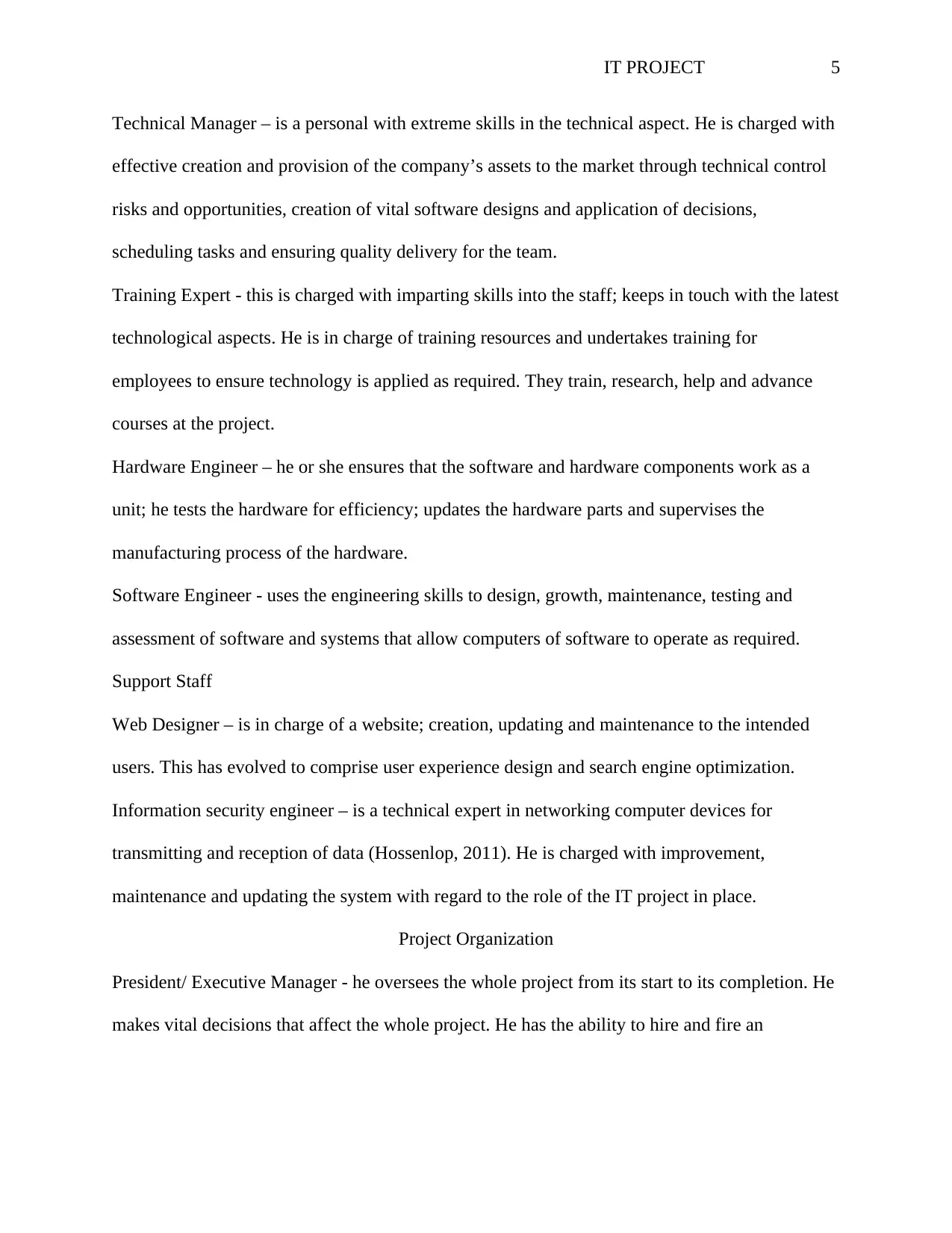
IT PROJECT 5
Technical Manager – is a personal with extreme skills in the technical aspect. He is charged with
effective creation and provision of the company’s assets to the market through technical control
risks and opportunities, creation of vital software designs and application of decisions,
scheduling tasks and ensuring quality delivery for the team.
Training Expert - this is charged with imparting skills into the staff; keeps in touch with the latest
technological aspects. He is in charge of training resources and undertakes training for
employees to ensure technology is applied as required. They train, research, help and advance
courses at the project.
Hardware Engineer – he or she ensures that the software and hardware components work as a
unit; he tests the hardware for efficiency; updates the hardware parts and supervises the
manufacturing process of the hardware.
Software Engineer - uses the engineering skills to design, growth, maintenance, testing and
assessment of software and systems that allow computers of software to operate as required.
Support Staff
Web Designer – is in charge of a website; creation, updating and maintenance to the intended
users. This has evolved to comprise user experience design and search engine optimization.
Information security engineer – is a technical expert in networking computer devices for
transmitting and reception of data (Hossenlop, 2011). He is charged with improvement,
maintenance and updating the system with regard to the role of the IT project in place.
Project Organization
President/ Executive Manager - he oversees the whole project from its start to its completion. He
makes vital decisions that affect the whole project. He has the ability to hire and fire an
Technical Manager – is a personal with extreme skills in the technical aspect. He is charged with
effective creation and provision of the company’s assets to the market through technical control
risks and opportunities, creation of vital software designs and application of decisions,
scheduling tasks and ensuring quality delivery for the team.
Training Expert - this is charged with imparting skills into the staff; keeps in touch with the latest
technological aspects. He is in charge of training resources and undertakes training for
employees to ensure technology is applied as required. They train, research, help and advance
courses at the project.
Hardware Engineer – he or she ensures that the software and hardware components work as a
unit; he tests the hardware for efficiency; updates the hardware parts and supervises the
manufacturing process of the hardware.
Software Engineer - uses the engineering skills to design, growth, maintenance, testing and
assessment of software and systems that allow computers of software to operate as required.
Support Staff
Web Designer – is in charge of a website; creation, updating and maintenance to the intended
users. This has evolved to comprise user experience design and search engine optimization.
Information security engineer – is a technical expert in networking computer devices for
transmitting and reception of data (Hossenlop, 2011). He is charged with improvement,
maintenance and updating the system with regard to the role of the IT project in place.
Project Organization
President/ Executive Manager - he oversees the whole project from its start to its completion. He
makes vital decisions that affect the whole project. He has the ability to hire and fire an
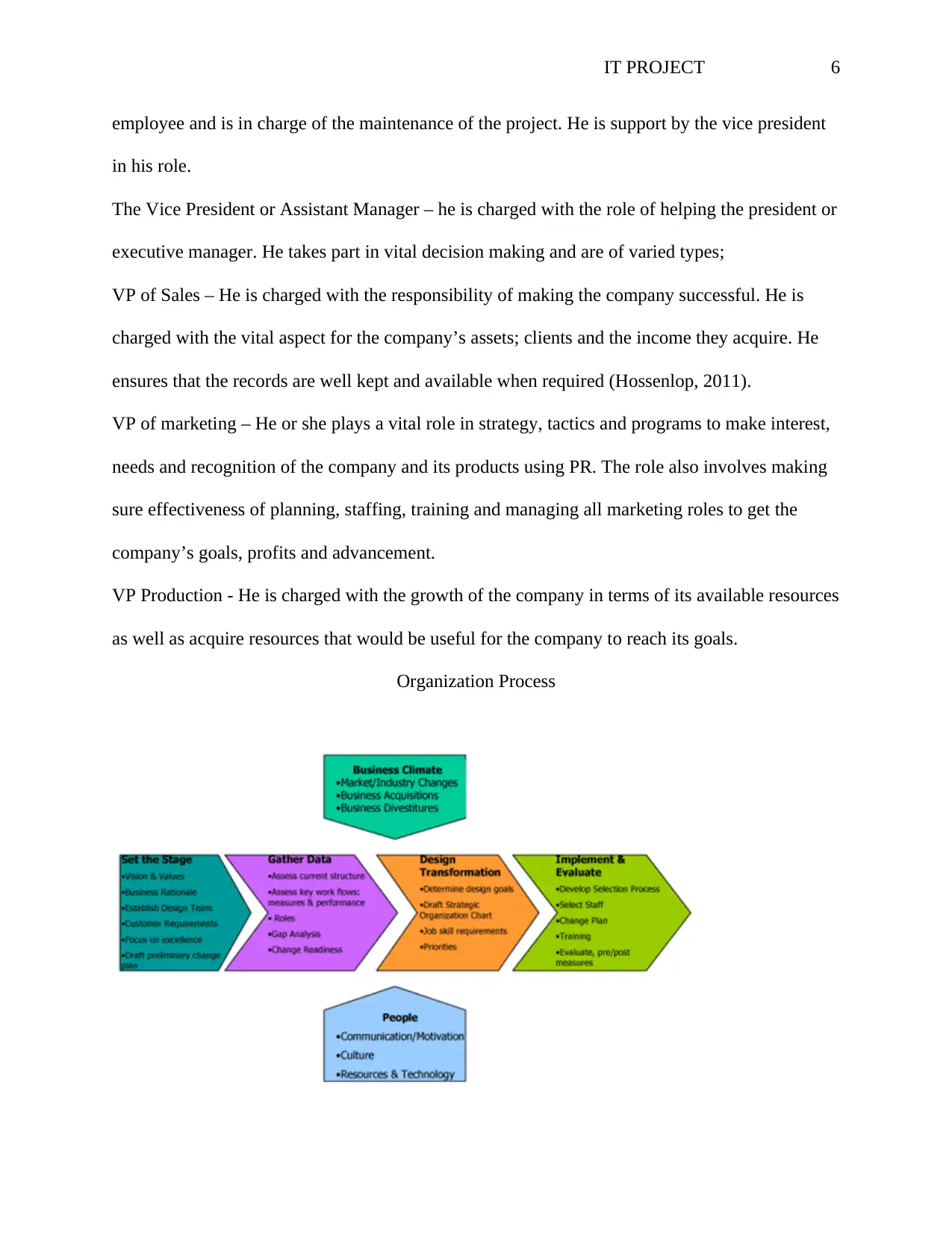
IT PROJECT 6
employee and is in charge of the maintenance of the project. He is support by the vice president
in his role.
The Vice President or Assistant Manager – he is charged with the role of helping the president or
executive manager. He takes part in vital decision making and are of varied types;
VP of Sales – He is charged with the responsibility of making the company successful. He is
charged with the vital aspect for the company’s assets; clients and the income they acquire. He
ensures that the records are well kept and available when required (Hossenlop, 2011).
VP of marketing – He or she plays a vital role in strategy, tactics and programs to make interest,
needs and recognition of the company and its products using PR. The role also involves making
sure effectiveness of planning, staffing, training and managing all marketing roles to get the
company’s goals, profits and advancement.
VP Production - He is charged with the growth of the company in terms of its available resources
as well as acquire resources that would be useful for the company to reach its goals.
Organization Process
employee and is in charge of the maintenance of the project. He is support by the vice president
in his role.
The Vice President or Assistant Manager – he is charged with the role of helping the president or
executive manager. He takes part in vital decision making and are of varied types;
VP of Sales – He is charged with the responsibility of making the company successful. He is
charged with the vital aspect for the company’s assets; clients and the income they acquire. He
ensures that the records are well kept and available when required (Hossenlop, 2011).
VP of marketing – He or she plays a vital role in strategy, tactics and programs to make interest,
needs and recognition of the company and its products using PR. The role also involves making
sure effectiveness of planning, staffing, training and managing all marketing roles to get the
company’s goals, profits and advancement.
VP Production - He is charged with the growth of the company in terms of its available resources
as well as acquire resources that would be useful for the company to reach its goals.
Organization Process
⊘ This is a preview!⊘
Do you want full access?
Subscribe today to unlock all pages.

Trusted by 1+ million students worldwide
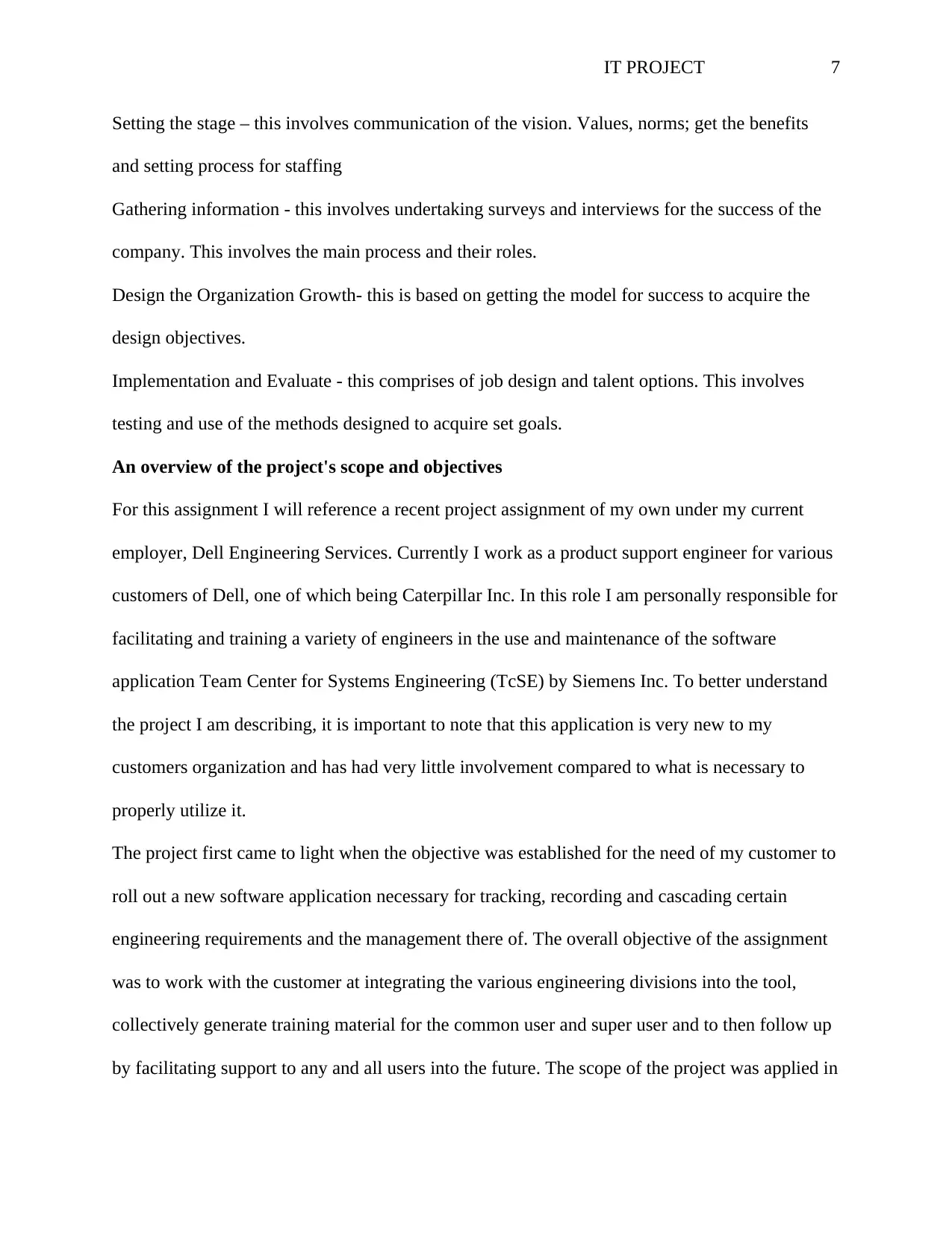
IT PROJECT 7
Setting the stage – this involves communication of the vision. Values, norms; get the benefits
and setting process for staffing
Gathering information - this involves undertaking surveys and interviews for the success of the
company. This involves the main process and their roles.
Design the Organization Growth- this is based on getting the model for success to acquire the
design objectives.
Implementation and Evaluate - this comprises of job design and talent options. This involves
testing and use of the methods designed to acquire set goals.
An overview of the project's scope and objectives
For this assignment I will reference a recent project assignment of my own under my current
employer, Dell Engineering Services. Currently I work as a product support engineer for various
customers of Dell, one of which being Caterpillar Inc. In this role I am personally responsible for
facilitating and training a variety of engineers in the use and maintenance of the software
application Team Center for Systems Engineering (TcSE) by Siemens Inc. To better understand
the project I am describing, it is important to note that this application is very new to my
customers organization and has had very little involvement compared to what is necessary to
properly utilize it.
The project first came to light when the objective was established for the need of my customer to
roll out a new software application necessary for tracking, recording and cascading certain
engineering requirements and the management there of. The overall objective of the assignment
was to work with the customer at integrating the various engineering divisions into the tool,
collectively generate training material for the common user and super user and to then follow up
by facilitating support to any and all users into the future. The scope of the project was applied in
Setting the stage – this involves communication of the vision. Values, norms; get the benefits
and setting process for staffing
Gathering information - this involves undertaking surveys and interviews for the success of the
company. This involves the main process and their roles.
Design the Organization Growth- this is based on getting the model for success to acquire the
design objectives.
Implementation and Evaluate - this comprises of job design and talent options. This involves
testing and use of the methods designed to acquire set goals.
An overview of the project's scope and objectives
For this assignment I will reference a recent project assignment of my own under my current
employer, Dell Engineering Services. Currently I work as a product support engineer for various
customers of Dell, one of which being Caterpillar Inc. In this role I am personally responsible for
facilitating and training a variety of engineers in the use and maintenance of the software
application Team Center for Systems Engineering (TcSE) by Siemens Inc. To better understand
the project I am describing, it is important to note that this application is very new to my
customers organization and has had very little involvement compared to what is necessary to
properly utilize it.
The project first came to light when the objective was established for the need of my customer to
roll out a new software application necessary for tracking, recording and cascading certain
engineering requirements and the management there of. The overall objective of the assignment
was to work with the customer at integrating the various engineering divisions into the tool,
collectively generate training material for the common user and super user and to then follow up
by facilitating support to any and all users into the future. The scope of the project was applied in
Paraphrase This Document
Need a fresh take? Get an instant paraphrase of this document with our AI Paraphraser
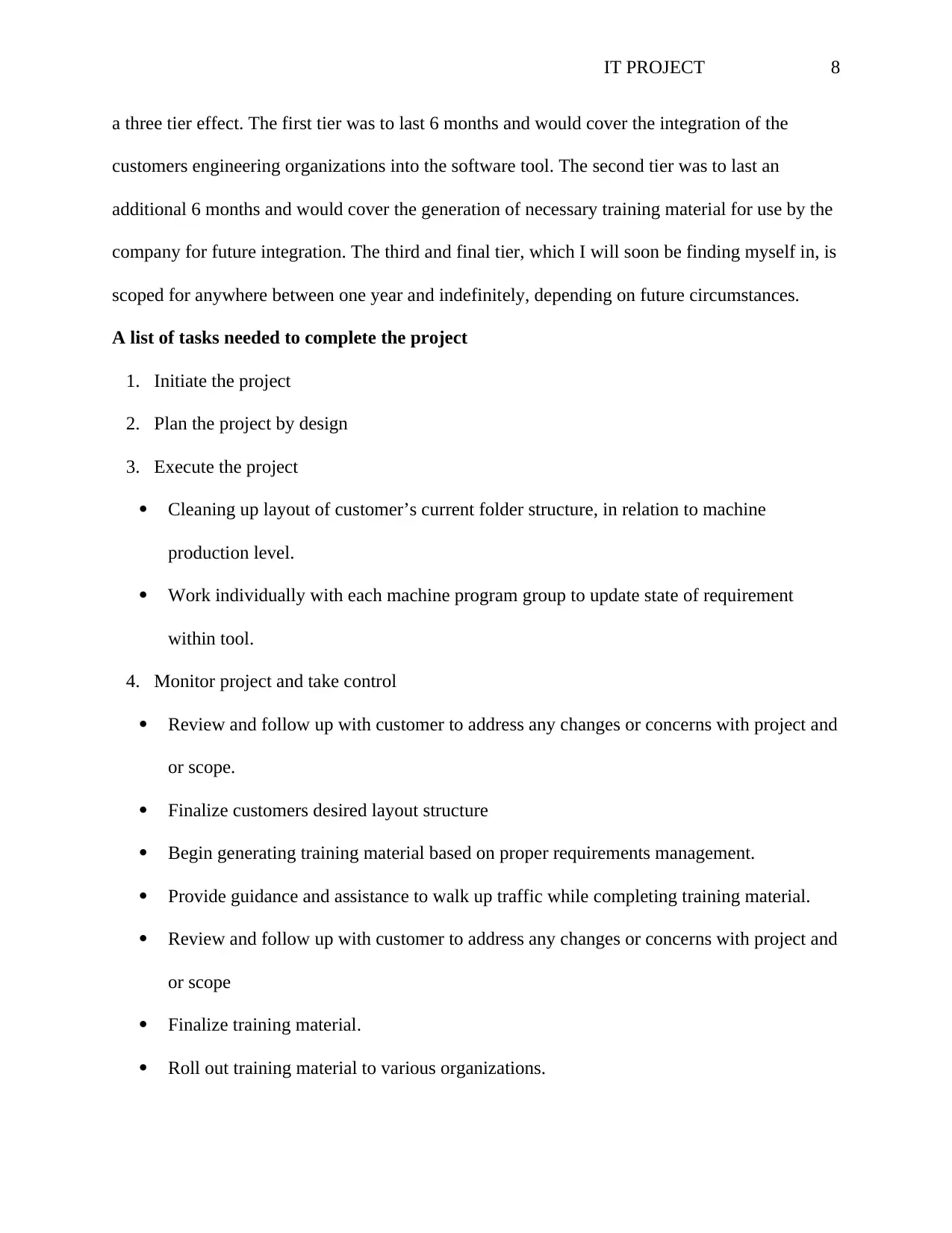
IT PROJECT 8
a three tier effect. The first tier was to last 6 months and would cover the integration of the
customers engineering organizations into the software tool. The second tier was to last an
additional 6 months and would cover the generation of necessary training material for use by the
company for future integration. The third and final tier, which I will soon be finding myself in, is
scoped for anywhere between one year and indefinitely, depending on future circumstances.
A list of tasks needed to complete the project
1. Initiate the project
2. Plan the project by design
3. Execute the project
Cleaning up layout of customer’s current folder structure, in relation to machine
production level.
Work individually with each machine program group to update state of requirement
within tool.
4. Monitor project and take control
Review and follow up with customer to address any changes or concerns with project and
or scope.
Finalize customers desired layout structure
Begin generating training material based on proper requirements management.
Provide guidance and assistance to walk up traffic while completing training material.
Review and follow up with customer to address any changes or concerns with project and
or scope
Finalize training material.
Roll out training material to various organizations.
a three tier effect. The first tier was to last 6 months and would cover the integration of the
customers engineering organizations into the software tool. The second tier was to last an
additional 6 months and would cover the generation of necessary training material for use by the
company for future integration. The third and final tier, which I will soon be finding myself in, is
scoped for anywhere between one year and indefinitely, depending on future circumstances.
A list of tasks needed to complete the project
1. Initiate the project
2. Plan the project by design
3. Execute the project
Cleaning up layout of customer’s current folder structure, in relation to machine
production level.
Work individually with each machine program group to update state of requirement
within tool.
4. Monitor project and take control
Review and follow up with customer to address any changes or concerns with project and
or scope.
Finalize customers desired layout structure
Begin generating training material based on proper requirements management.
Provide guidance and assistance to walk up traffic while completing training material.
Review and follow up with customer to address any changes or concerns with project and
or scope
Finalize training material.
Roll out training material to various organizations.
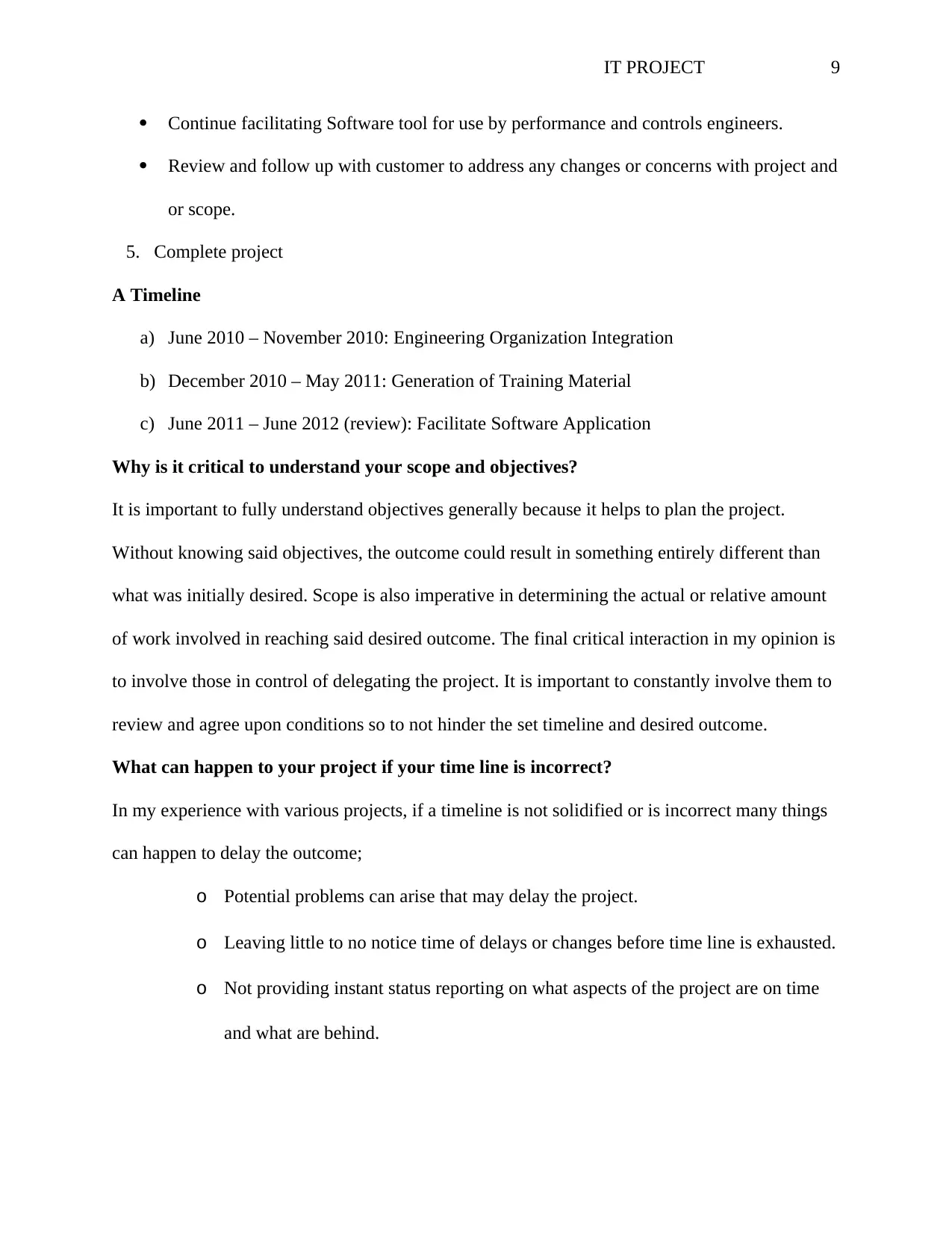
IT PROJECT 9
Continue facilitating Software tool for use by performance and controls engineers.
Review and follow up with customer to address any changes or concerns with project and
or scope.
5. Complete project
A Timeline
a) June 2010 – November 2010: Engineering Organization Integration
b) December 2010 – May 2011: Generation of Training Material
c) June 2011 – June 2012 (review): Facilitate Software Application
Why is it critical to understand your scope and objectives?
It is important to fully understand objectives generally because it helps to plan the project.
Without knowing said objectives, the outcome could result in something entirely different than
what was initially desired. Scope is also imperative in determining the actual or relative amount
of work involved in reaching said desired outcome. The final critical interaction in my opinion is
to involve those in control of delegating the project. It is important to constantly involve them to
review and agree upon conditions so to not hinder the set timeline and desired outcome.
What can happen to your project if your time line is incorrect?
In my experience with various projects, if a timeline is not solidified or is incorrect many things
can happen to delay the outcome;
o Potential problems can arise that may delay the project.
o Leaving little to no notice time of delays or changes before time line is exhausted.
o Not providing instant status reporting on what aspects of the project are on time
and what are behind.
Continue facilitating Software tool for use by performance and controls engineers.
Review and follow up with customer to address any changes or concerns with project and
or scope.
5. Complete project
A Timeline
a) June 2010 – November 2010: Engineering Organization Integration
b) December 2010 – May 2011: Generation of Training Material
c) June 2011 – June 2012 (review): Facilitate Software Application
Why is it critical to understand your scope and objectives?
It is important to fully understand objectives generally because it helps to plan the project.
Without knowing said objectives, the outcome could result in something entirely different than
what was initially desired. Scope is also imperative in determining the actual or relative amount
of work involved in reaching said desired outcome. The final critical interaction in my opinion is
to involve those in control of delegating the project. It is important to constantly involve them to
review and agree upon conditions so to not hinder the set timeline and desired outcome.
What can happen to your project if your time line is incorrect?
In my experience with various projects, if a timeline is not solidified or is incorrect many things
can happen to delay the outcome;
o Potential problems can arise that may delay the project.
o Leaving little to no notice time of delays or changes before time line is exhausted.
o Not providing instant status reporting on what aspects of the project are on time
and what are behind.
⊘ This is a preview!⊘
Do you want full access?
Subscribe today to unlock all pages.

Trusted by 1+ million students worldwide
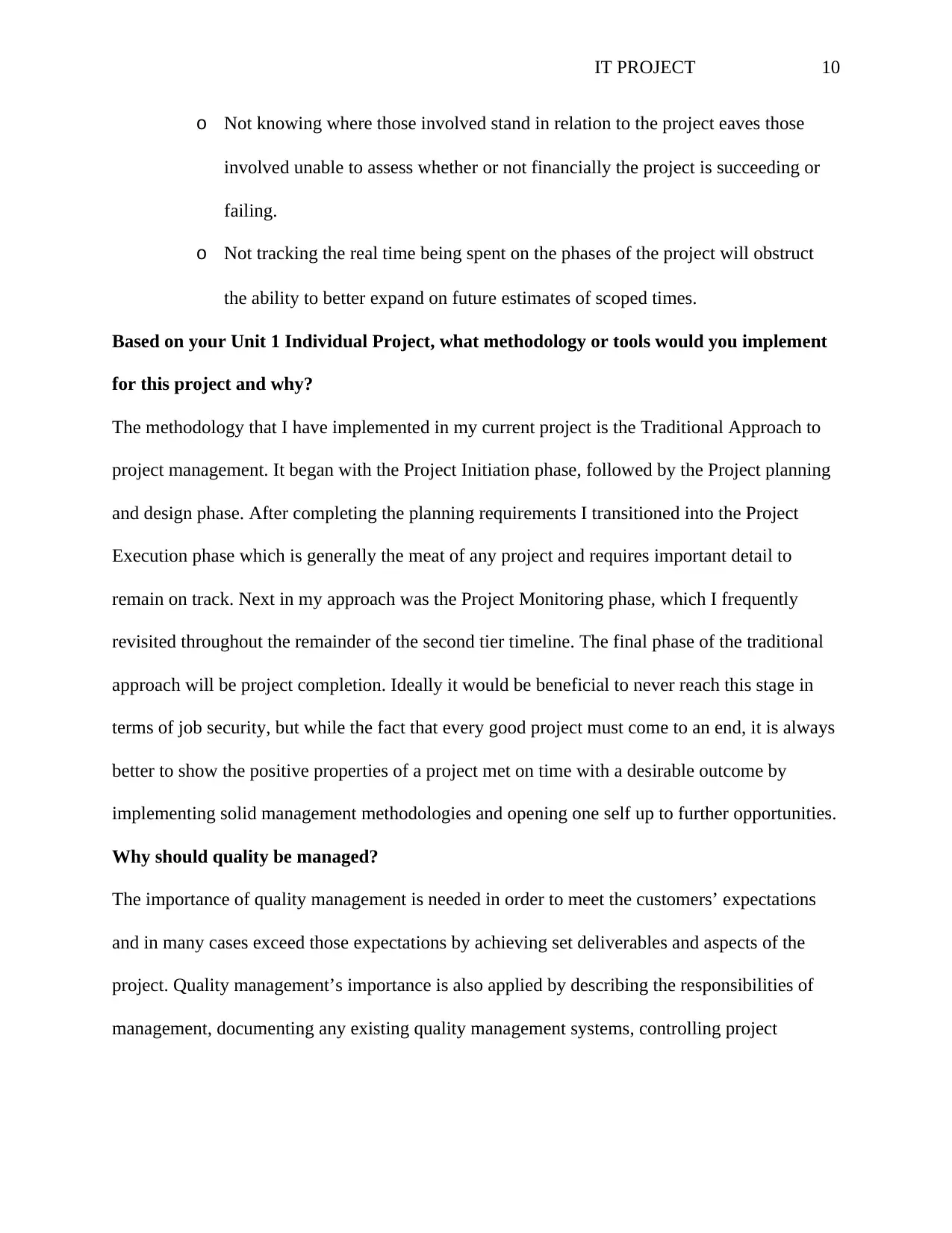
IT PROJECT 10
o Not knowing where those involved stand in relation to the project eaves those
involved unable to assess whether or not financially the project is succeeding or
failing.
o Not tracking the real time being spent on the phases of the project will obstruct
the ability to better expand on future estimates of scoped times.
Based on your Unit 1 Individual Project, what methodology or tools would you implement
for this project and why?
The methodology that I have implemented in my current project is the Traditional Approach to
project management. It began with the Project Initiation phase, followed by the Project planning
and design phase. After completing the planning requirements I transitioned into the Project
Execution phase which is generally the meat of any project and requires important detail to
remain on track. Next in my approach was the Project Monitoring phase, which I frequently
revisited throughout the remainder of the second tier timeline. The final phase of the traditional
approach will be project completion. Ideally it would be beneficial to never reach this stage in
terms of job security, but while the fact that every good project must come to an end, it is always
better to show the positive properties of a project met on time with a desirable outcome by
implementing solid management methodologies and opening one self up to further opportunities.
Why should quality be managed?
The importance of quality management is needed in order to meet the customers’ expectations
and in many cases exceed those expectations by achieving set deliverables and aspects of the
project. Quality management’s importance is also applied by describing the responsibilities of
management, documenting any existing quality management systems, controlling project
o Not knowing where those involved stand in relation to the project eaves those
involved unable to assess whether or not financially the project is succeeding or
failing.
o Not tracking the real time being spent on the phases of the project will obstruct
the ability to better expand on future estimates of scoped times.
Based on your Unit 1 Individual Project, what methodology or tools would you implement
for this project and why?
The methodology that I have implemented in my current project is the Traditional Approach to
project management. It began with the Project Initiation phase, followed by the Project planning
and design phase. After completing the planning requirements I transitioned into the Project
Execution phase which is generally the meat of any project and requires important detail to
remain on track. Next in my approach was the Project Monitoring phase, which I frequently
revisited throughout the remainder of the second tier timeline. The final phase of the traditional
approach will be project completion. Ideally it would be beneficial to never reach this stage in
terms of job security, but while the fact that every good project must come to an end, it is always
better to show the positive properties of a project met on time with a desirable outcome by
implementing solid management methodologies and opening one self up to further opportunities.
Why should quality be managed?
The importance of quality management is needed in order to meet the customers’ expectations
and in many cases exceed those expectations by achieving set deliverables and aspects of the
project. Quality management’s importance is also applied by describing the responsibilities of
management, documenting any existing quality management systems, controlling project
Paraphrase This Document
Need a fresh take? Get an instant paraphrase of this document with our AI Paraphraser
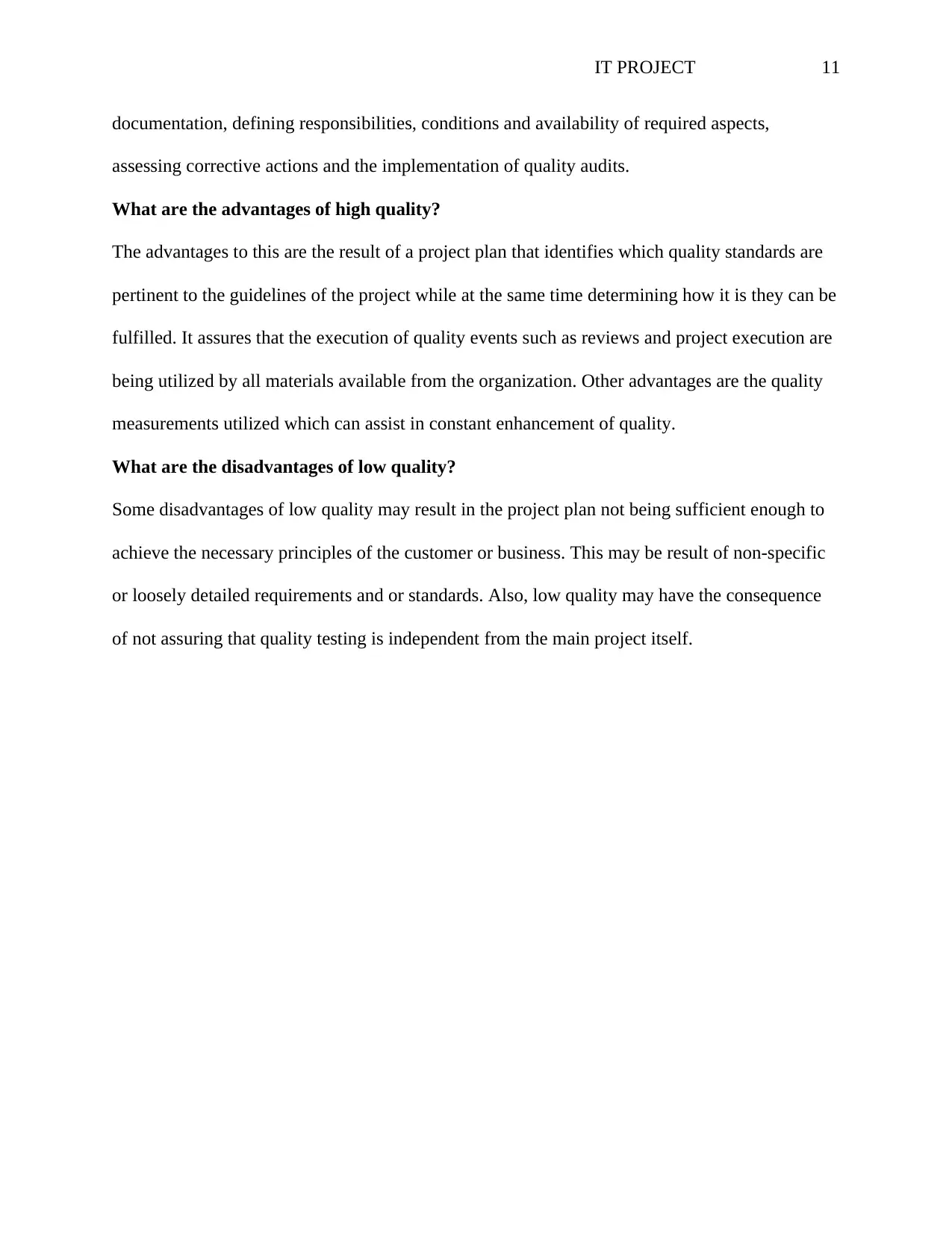
IT PROJECT 11
documentation, defining responsibilities, conditions and availability of required aspects,
assessing corrective actions and the implementation of quality audits.
What are the advantages of high quality?
The advantages to this are the result of a project plan that identifies which quality standards are
pertinent to the guidelines of the project while at the same time determining how it is they can be
fulfilled. It assures that the execution of quality events such as reviews and project execution are
being utilized by all materials available from the organization. Other advantages are the quality
measurements utilized which can assist in constant enhancement of quality.
What are the disadvantages of low quality?
Some disadvantages of low quality may result in the project plan not being sufficient enough to
achieve the necessary principles of the customer or business. This may be result of non-specific
or loosely detailed requirements and or standards. Also, low quality may have the consequence
of not assuring that quality testing is independent from the main project itself.
documentation, defining responsibilities, conditions and availability of required aspects,
assessing corrective actions and the implementation of quality audits.
What are the advantages of high quality?
The advantages to this are the result of a project plan that identifies which quality standards are
pertinent to the guidelines of the project while at the same time determining how it is they can be
fulfilled. It assures that the execution of quality events such as reviews and project execution are
being utilized by all materials available from the organization. Other advantages are the quality
measurements utilized which can assist in constant enhancement of quality.
What are the disadvantages of low quality?
Some disadvantages of low quality may result in the project plan not being sufficient enough to
achieve the necessary principles of the customer or business. This may be result of non-specific
or loosely detailed requirements and or standards. Also, low quality may have the consequence
of not assuring that quality testing is independent from the main project itself.
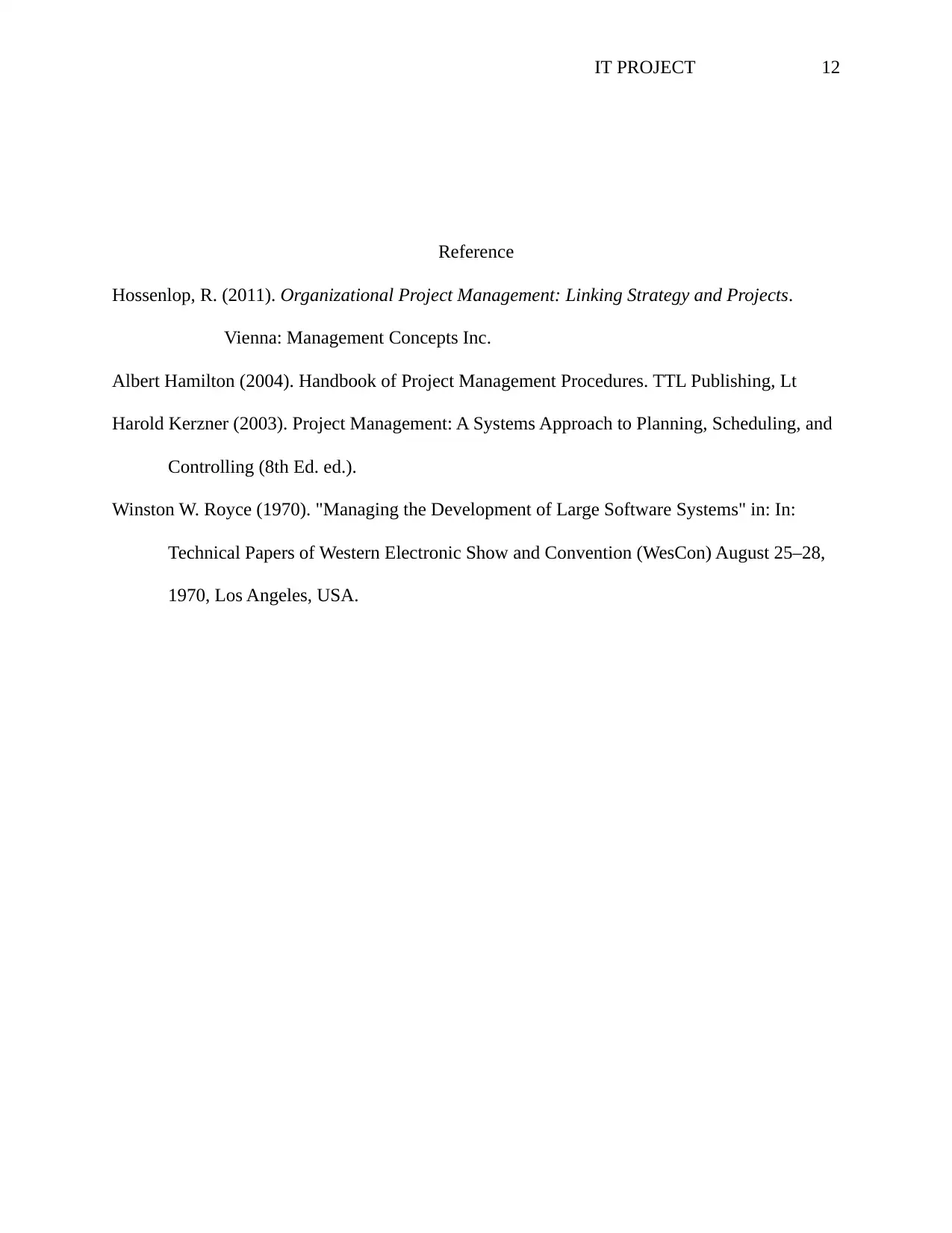
IT PROJECT 12
Reference
Hossenlop, R. (2011). Organizational Project Management: Linking Strategy and Projects.
Vienna: Management Concepts Inc.
Albert Hamilton (2004). Handbook of Project Management Procedures. TTL Publishing, Lt
Harold Kerzner (2003). Project Management: A Systems Approach to Planning, Scheduling, and
Controlling (8th Ed. ed.).
Winston W. Royce (1970). "Managing the Development of Large Software Systems" in: In:
Technical Papers of Western Electronic Show and Convention (WesCon) August 25–28,
1970, Los Angeles, USA.
Reference
Hossenlop, R. (2011). Organizational Project Management: Linking Strategy and Projects.
Vienna: Management Concepts Inc.
Albert Hamilton (2004). Handbook of Project Management Procedures. TTL Publishing, Lt
Harold Kerzner (2003). Project Management: A Systems Approach to Planning, Scheduling, and
Controlling (8th Ed. ed.).
Winston W. Royce (1970). "Managing the Development of Large Software Systems" in: In:
Technical Papers of Western Electronic Show and Convention (WesCon) August 25–28,
1970, Los Angeles, USA.
⊘ This is a preview!⊘
Do you want full access?
Subscribe today to unlock all pages.

Trusted by 1+ million students worldwide
1 out of 12
Related Documents
Your All-in-One AI-Powered Toolkit for Academic Success.
+13062052269
info@desklib.com
Available 24*7 on WhatsApp / Email
![[object Object]](/_next/static/media/star-bottom.7253800d.svg)
Unlock your academic potential
Copyright © 2020–2025 A2Z Services. All Rights Reserved. Developed and managed by ZUCOL.





